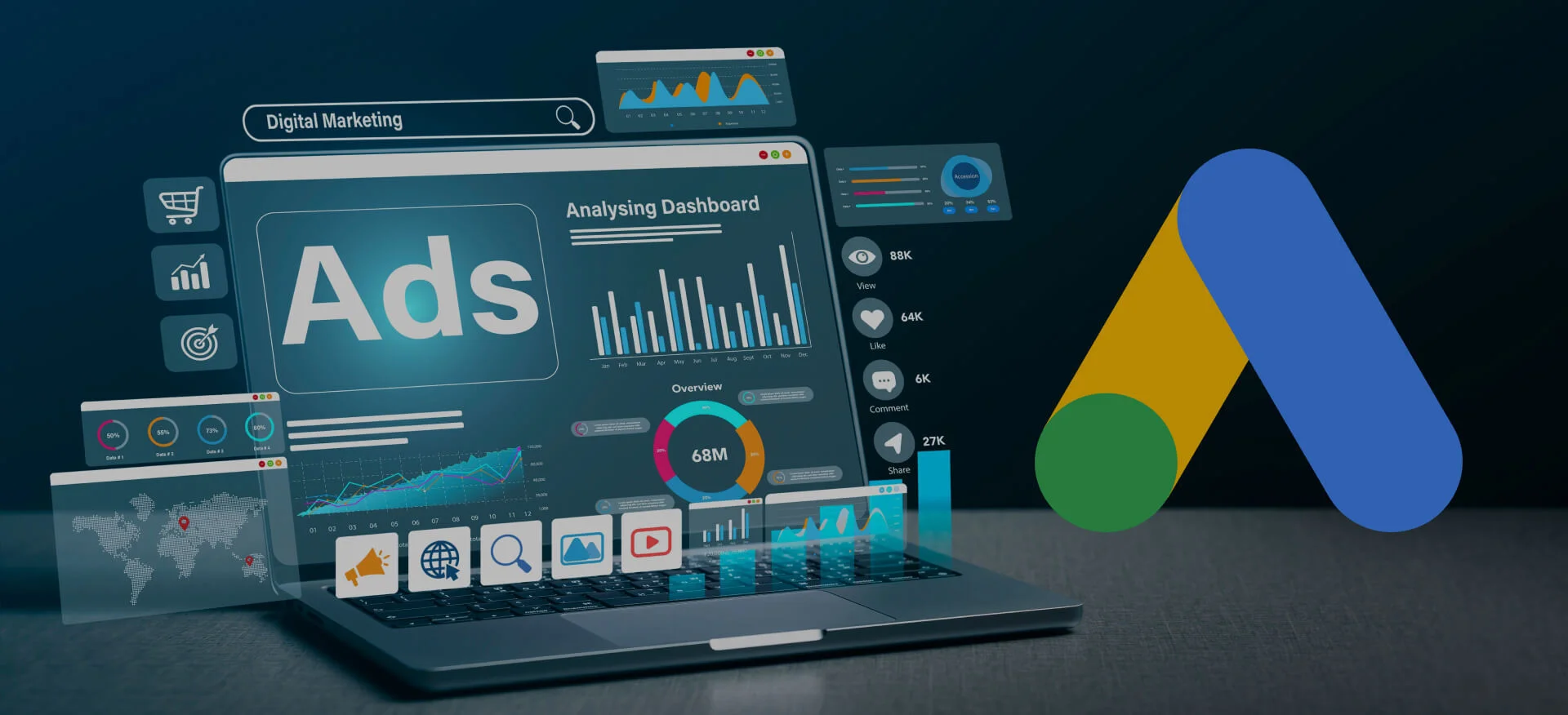Digital marketing is more competitive than ever, with businesses of all sizes striving to drive traffic, boost conversions, and maximize ROI.
A common question that often arises is: Are Google Ads worth it?
The answer is yes because over 80% of desktop searches happen on Google.
According to Google estimates, businesses earn an 800% ROI, making $8 for every $1 spent.
With Google projected to generate over $340 billion in ad revenue by 2027, it’s clear that businesses see real value in Google Ads to reach their target audience.
In this post, we will explore the types of Google ads businesses can use, the benefits, cost analysis, ROI, and other key strategies.
Whether you're new to pay-per-click (PPC) advertising or looking to fine-tune your campaigns, this article breaks down everything you need to know to determine whether Google Ads aligns with your marketing goals.
What Are Google Ads?
Google Ads, previously known as Google AdWords, is Google’s powerful online advertising platform that allows businesses to promote their products or services across a vast digital network.
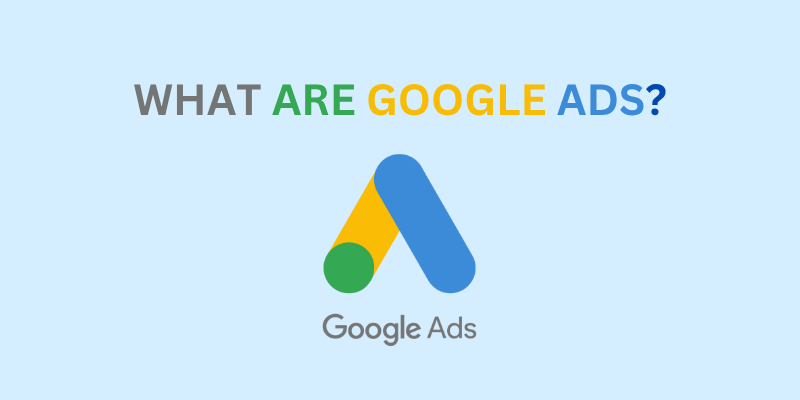
This includes placements on Google’s search engine results pages (SERPs), YouTube videos, Gmail inboxes, and millions of partner websites through the Google Display Network.
At its core, Google Ads operates on a pay-per-click (PPC) model where advertisers bid on keywords, and their ads appear when users search for those terms. If you’ve ever wondered how do Google Ads work or asked yourself what is AdWords, the process is essentially the same—performance-based and highly scalable.
You only pay when someone clicks your ad, making it a performance-based model with high scalability.
In the first few months of 2025, Google made more than 89.52 billion U.S. dollars. This is higher than the 79.97 billion dollars it made in the same period the year before.
In all of 2024, Google earned 348.16 billion dollars, which is the most it has ever made. Most of this money comes from advertising on Google’s websites and through its network.
Using its Google Ads platform, businesses can show ads, product listings, and services on many websites and apps connected to Google.
Whether you’re looking to boost sales, generate leads, or grow brand awareness, digital branding consultants can help you optimize your Google Ads strategy for maximum impact.
Also, Google earned 234.2 billion dollars just from ads shown on its own websites, which made up most of the total income for its parent company, Alphabet.
So, whether you're aiming to boost sales, generate leads, or grow brand awareness, Google Ads remains a key element in digital marketing strategy due to its global reach, robust targeting options, and measurable results.
Explore Our Performance Marketing Services!
How Does Google Ads Work?
![]()
For beginners exploring how does Google Ads work or businesses seeking professional AdWords services, this step is the foundation of every campaign.
When a user types a search query that matches one of these keywords, Google instantly conducts an ad auction to decide which ads will appear and in what order.
Several key metrics influence this process:
1. Quality Score
This is Google’s rating of the relevance and quality of your ad, keywords, and landing page. A higher Quality Score can lower your costs and improve your ad placement.
2. Ad Rank
Your Ad Rank determines where your ad appears on the page. It’s calculated using your bid amount, Quality Score, the expected impact of ad extensions, and other factors.
3. CPC (Cost-Per-Click)
This is the actual amount you pay when someone clicks on your ad. It can vary depending on your competition and the quality of your ad.
This system ensures that well-optimized and relevant ads have the opportunity to perform well even with a modest budget. Using performance marketing solutions can help businesses optimize their Google Ads campaigns to maximize ROI and ensure that every dollar spent is working efficiently.
Types of Google Ads Campaigns
To get the most out of Google Ads, it’s essential to understand the different types of campaigns available.
Each serves a unique purpose depending on your business goals, whether it's driving website traffic, generating leads, or increasing app installs.
1. Search Ads
These are text-based ads that appear at the top or bottom of Google’s search engine results pages (SERPs) when users search for specific keywords. They’re ideal for capturing high-intent traffic from people actively looking for your products or services, making them especially valuable for Google Ads for small business campaigns or companies investing in AdWords advertising.
2. Display Ads
These are visually engaging banner or image ads that show up on over 2 million websites and apps within the Google Display Network. They’re great for increasing brand awareness and reaching users while they browse online.
3. Shopping Ads
Perfect for eCommerce businesses, Shopping Ads showcase product images, prices, store names, and reviews directly in search results. These ads appear when users are searching for specific products and help drive direct purchases.
4. Video Ads
Displayed before, during, or after YouTube videos, Video Ads help capture attention through motion and sound. These are effective for storytelling, branding, and increasing engagement.
For businesses aiming to enhance both their digital marketing efforts and user experience, incorporating progressive web app development services can optimize the way customers interact with your ads, boosting engagement and conversion rates.
5. App Campaigns
These campaigns are designed to promote mobile apps across Google Search, YouTube, Google Play, and the Display Network. Google automatically optimizes your ads to drive app installs or in-app actions.
Additionally, businesses within niche industries like energy or oil and gas SEO can leverage Google Ads to target highly specific markets, ensuring their ads reach the right audience at the right time.
Integrating a business branding service with your Google Ads strategy can enhance brand recognition and ensure a cohesive digital presence across all campaign types.
Are Google Ads Worth It?
Yes, Google Ads are worth it for many businesses because they provide immediate visibility, targeted reach, and measurable results. With over 80% of desktop searches happening on Google, the platform allows advertisers to connect with potential customers at the exact moment they are searching for products or services. Whether you’re running Google Ads for small business campaigns or large-scale AdWords marketing strategies, the pay-per-click (PPC) model ensures you only pay when someone engages with your ad. Ultimately, the value depends on your budget, industry, and ability to optimize campaigns—but with the right approach, Google Ads can deliver a strong return on investment.
Benefits of Using Google Ads
Google Ads offers a wide range of advantages for businesses looking to grow online. Whether you're aiming to drive leads, boost sales, or increase brand awareness, the platform provides flexible tools to achieve your goals.
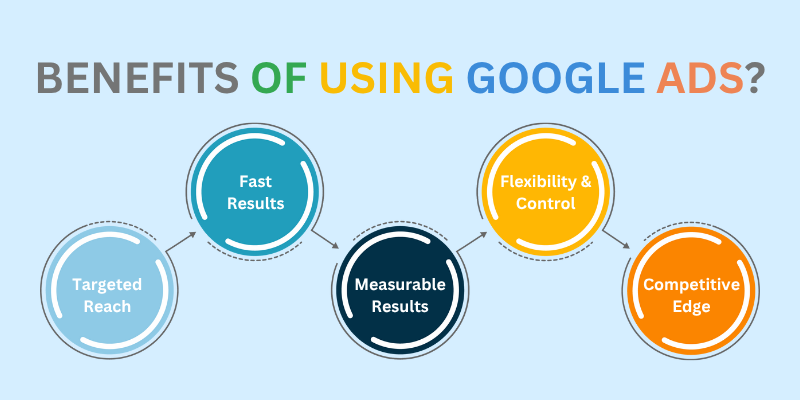
Here are some of the top benefits:
1. Targeted Reach
Google Ads allows you to zero in on your ideal audience with precision. You can target users based on location, language, device type, age, gender, interests, online behavior, and even the time of day.
This ensures your ads are shown only to people most likely to engage with your business, making it a core tool in best performance marketing services and strategies aimed at maximizing engagement and conversions.
Additionally, integrating Design and Branding Services into your ad strategy can help create visually compelling ads that resonate more deeply with your target audience.
2. Fast Results
While SEO services are a long-term strategy, Google Ads can generate traffic almost immediately. Once your campaign goes live, your ads start appearing, making it ideal for product launches, flash sales, or urgent promotions. For businesses looking for more budget-friendly options to complement paid ads, cheap SEO services can help enhance organic search results over time, providing additional visibility.
3. Measurable Results
One of the strongest advantages is the ability to measure everything. Whether you’re testing AdWords marketing campaigns or refining your AdWords service strategies, Google Ads provides transparent and detailed reporting. Google Ads integrates seamlessly with Google Analytics, allowing you to track impressions, clicks, conversions, and costs. This level of insight helps you make data-driven decisions and improve ROI over time.
4. Flexibility and Control
You can pause, resume, or modify campaigns at any moment. Adjust budgets, switch keywords, or tweak ad copy on the fly.
This makes Google Ads highly adaptable for seasonal campaigns, A/B testing, or reacting to changes in customer behavior.
5. Competitive Edge
Google Ads gives you a chance to outrank competitors by placing your business above organic search results.
In saturated industries, this prime positioning can be crucial for standing out and attracting high-intent users before they see other options.
For businesses looking to complement their paid efforts, enterprise SEO solutions can help improve organic rankings, ensuring long-term visibility alongside Google Ads campaigns.
Some Drawbacks of Google Ads
While Google Ads offers tremendous potential, it’s not a guaranteed win. Poor planning, lack of optimization, or misunderstanding how the platform works can lead to wasted spend and disappointing results.
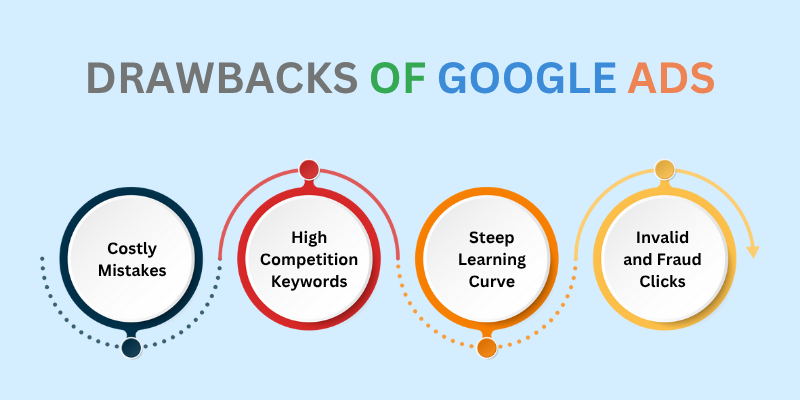
Here are some common challenges and pitfalls to watch out for:
1. Costly Mistakes
If your campaigns are not properly structured or closely monitored, your advertising budget can quickly be depleted without producing meaningful returns.
Common errors include bidding on overly broad keywords, ignoring negative keywords, or directing traffic to poorly optimized landing pages, highlighting the importance of leveraging Digital Branding Services to streamline and optimize your advertising workflows.
2. High Competition Keywords
In competitive industries like insurance, legal services, or finance, cost-per-click (CPC) rates can skyrocket, sometimes exceeding $50 per click.
For small businesses with limited budgets, this can make it difficult to stay competitive without highly targeted campaigns and excellent ad quality.
3. Steep Learning Curve
Running successful campaigns requires more than just creating an ad. You need to understand keyword research, bidding strategies, audience segmentation, ad copywriting, and data analysis.
4. Invalid and Fraud Clicks
Unfortunately, some competitors or bots may click on your ads repeatedly with no intention of converting, wasting your ad spend.
While Google has systems in place to detect and refund invalid clicks, it’s not foolproof. Regular monitoring and third-party fraud protection tools can help mitigate this risk.
Cost Factors and Budgeting
When considering whether Google Ads are worth it, understanding the cost structure is essential.
One of the primary cost factors is the cost-per-click (CPC), which can vary widely depending on your industry.
For example, highly competitive sectors like law and insurance may see CPCs exceeding $50 per click, while less competitive markets may have significantly lower rates.
Another important element is your daily budget. With Google Ads, you set a maximum amount you're willing to spend each day, and Google aims to average that spend over a 30-day period.
This gives you control and predictability over your monthly ad expenses, which is especially important for small businesses and companies involved in B2B marketing with tight budgets.
Your bidding strategy also plays a major role in how much you spend and how effectively your ads perform.
Google offers both manual bidding, where you set your bids yourself, and automated bidding, where Google adjusts bids to help you meet specific goals like maximizing conversions or impression share.
Measuring Google Ads ROI
When deciding whether Google Ads are worth it for your business, the most important factor to consider is your return on ad spend (ROAS).
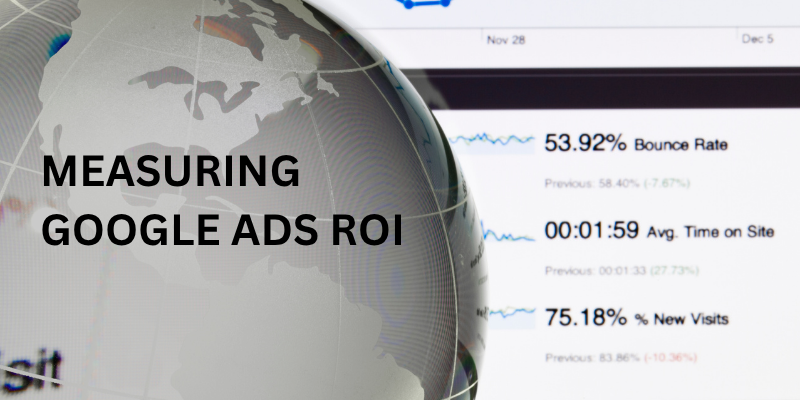
This metric helps you evaluate whether your advertising investment is delivering profitable results based on your specific business goals, whether that’s generating leads, driving sales, or increasing sign-ups.
To accurately assess ROAS, you need to implement conversion tracking, which allows you to monitor key actions taken by users after clicking your ad.
Tools like Google Tag Manager make it easier to set up tracking for different types of conversions, such as purchases, form submissions, phone calls, or newsletter sign-ups, an essential step for companies offering progressive web app development services that rely heavily on digital engagement metrics.
Beyond conversion tracking, it's crucial to analyze key performance indicators (KPIs) such as Click-Through Rate (CTR), Conversion Rate, Cost-per-Acquisition (CPA), and Customer Lifetime Value (LTV).
These metrics help you understand not just how many people are clicking your ads, but how many of those clicks are turning into meaningful business outcomes.
Google Ads vs. SEO
One of the most common questions marketers face is whether to invest in Google Ads or search engine optimization (SEO).
Both strategies offer unique advantages, and the right choice often depends on your goals, timeline, and budget.
1. Google Ads
Google Ads is ideal if you're looking for immediate results. It allows your business to appear at the top of search results quickly, but you’ll pay for every click, and once your budget runs out, your visibility disappears.
It’s highly effective for time-sensitive campaigns, product launches, or when you need quick leads, especially useful for agencies providing web app development services where client acquisition speed can be critical.
2. SEO
SEO is a long-term investment. It focuses on building organic rankings through quality content, backlinks, and technical optimization.
While it takes more time to see results, SEO services can deliver consistent, high-quality traffic over the long run without ongoing ad spend.
Additionally, it often yields a higher return on investment once established.
The most effective approach is to combine both. Use digital marketing services like Google Ads to generate short-term wins and test keyword performance, while simultaneously building out your SEO strategy for sustained, long-term growth. Additionally, integrating branding services into your overall marketing plan can strengthen your brand's presence both in ads and organic search results, creating a cohesive and memorable identity.
Get Your Free Consultation Now!
Alternatives to Google Ads
If Google Ads isn’t delivering the results you expect or is stretching your budget too thin, there are several effective alternatives to consider, though Google Ads for small business campaigns remains one of the most reliable ways to gain quick visibility.
1. Facebook Ads
Better for interest-based targeting with precise audience segmentation based on demographics, behaviors, and preferences.
2. Microsoft Ads
Typically offers lower cost-per-click (CPC) rates while reaching millions through Bing and partner sites.
3. SEO Services
Focuses on building organic visibility and driving consistent, unpaid traffic over the long term.
4. Influencer Marketing
Leverages social proof by partnering with trusted voices to reach engaged and loyal audiences.
5. Content Marketing
Creates valuable, educational content using content marketing tools that build trust and authority, attracting customers organically.
How to Set Yourself Up for Success with Google Ads?
Starting without a plan is like wasting money. So, first, do some research.
Before making your ads, work with a digital marketing agency to decide on a budget, choose the right keywords, organize your ads into groups, and create good landing pages.
After your ads are live, watch your Google Analytics and make changes to your campaign if needed. Turn on conversion tracking to see what is working and what is not.
If you are new to this, it’s smart to let a skilled digital marketing agency manage your ads and check your analytics. They can make changes to help you get the best results for your money and time.
Additionally, investing in brand marketing services can help ensure your ads are consistent with your overall brand identity, maximizing the impact of your campaign.
FAQs: Are Google Ads Worth It
Are Google Ads worth it for small businesses?
Yes, Google Ads are worth it for small businesses because they provide immediate visibility in search results and allow you to target only the right audience. With careful budgeting and keyword targeting, Google Ads for small business campaigns can generate quality leads and boost sales without wasting spend.
How does Google Ads work for marketers?
Google Ads works on a pay-per-click (PPC) model where advertisers bid on keywords, and ads appear when users search for those terms. Understanding how does Google Ads work helps marketers maximize ROI by focusing on ad quality, relevance, and conversion tracking.
What is the ROI of Google Ads?
According to Google, businesses typically earn around $8 in revenue for every $1 spent on ads, making the ROI highly attractive. The actual return depends on your industry, campaign optimization, and whether you use professional AdWords services or manage it in-house.
Are Google Ads better than SEO?
Google Ads delivers instant visibility and traffic, while SEO is a long-term strategy that builds sustainable organic rankings. For marketers, combining AdWords advertising with SEO offers both immediate results and lasting growth in online visibility.
How do I know if Google Ads are working for my business?
You can measure success through key metrics like click-through rate (CTR), cost-per-acquisition (CPA), and conversion tracking. If your campaigns align with your goals and deliver positive ROI, then the answer to are Google Ads worth it for your business is a clear yes.
Final Thoughts
So, are Google Ads worth it? The answer isn’t a straightforward yes or no. Just as businesses often ask how do Google Ads work, the effectiveness depends largely on budget, marketing goals, and optimization efforts. It largely depends on your business type, budget, marketing goals, and your willingness to invest time and effort into optimizing your campaigns.
Google Ads are worth it if you’re looking for fast, measurable results, have a well-defined customer persona, consistently track conversions and ROI, and regularly refine your campaigns based on data insights.
On the other hand, Google Ads may not be worth it if you lack a clear budget or strategy, are unwilling to experiment and learn from results, or don’t have compelling calls-to-action and optimized landing pages to convert traffic effectively.
Lastly, success with Google Ads requires strategic planning, ongoing management, and a focus on continuous improvement.
